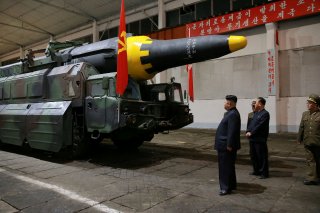See the Picture: Admiral Says North Korea Poses ‘Serious’ and ‘Immediate’ Danger
Adm. Phil Davidson has noted that North Korea over the years has continued to develop its nuclear and delivery systems that are designed to strike the United States.
The United States and its allies in the Pacific should be on guard as North Korea poses a “serious” and “immediate” threat, according to Adm. Phil Davidson, the commander of U.S. Indo-Pacific Command.
He noted that North Korea over the years has continued to develop its nuclear and delivery systems that are designed to strike the United States.
“North Korea poses a significant security risk to the United States and our partners in the Indo Pacific Region. The country has taken no meaningful steps toward denuclearization, despite promising signs of de-escalation in 2018, and it continues to advance its strategic weapons program,” Davidson said in a statement submitted to the Senate Armed Services Committee prior to a Senate hearing on Tuesday.
“Until the nuclear situation is resolved on the Korean Peninsula, North Korea will remain our most immediate threat.”
The four-star admiral added that North Korean leader Kim Jong-un has continued to develop weapons of mass destruction despite its self-imposed moratorium in late 2017 on nuclear and long-range missile testing.
“Pyongyang maintains a diverse and growing missile inventory, and North Korea unveiled several new ballistic systems during military parades in late 2020 and early 2021, including two SLBMs and an ICBM,” Davidson wrote.
Kim’s regime also has taken on an increasingly “bellicose” stance toward the United States.
“In early 2021 he characterized the United States as the North’s biggest or principal enemy as he vowed to strengthen its nuclear arsenal. Kim also identified several new weapon modernization goals in early 2021, to include developing tactical nuclear weapons and hypersonic glide vehicles and improving the readiness and accuracy of North Korea’s ICBMs,” Davidson said.
“Pyongyang’s missile research and development efforts, coupled with its ongoing pursuit of nuclear material and technology, are consistent with the regime’s stated objective of being able to strike the U.S. homeland,” he added.
Meanwhile, Davidson wanted the United States and South Korea to quickly sign off on the Special Measures Agreement (SMA), which sets Seoul’s share of the financial cost in maintaining U.S. troops on the Korean Peninsula.
Over the past weekend, the two countries announced that they reached a “consensus” on the text of a new SMA that is believed to be effective for six years, but it has yet to be fully reviewed by the respective governments.
In 2019, South Korea was responsible for roughly $870 million in order to maintain the 28,500 U.S. troops in South Korea.
“The United States and ROK are currently addressing a lapse in the Special Measures Agreement, which we expect to be finalized in the near term,” Davidson said.
“The lack of an SMA negatively impacts USFK’s ability to ‘fight tonight,’” he added.
Ethen Kim Lieser is a Minneapolis-based Science and Tech Editor who has held posts at Google, The Korea Herald, Lincoln Journal Star, AsianWeek, and Arirang TV. Follow or contact him on LinkedIn.
Image: Reuters

